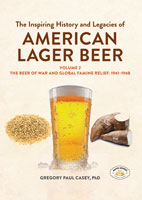 By Gregory Paul Casey The series examines the history of the American lager brewing between the 1840s and the 1940s. A period and a beer little studied by historians, the political, societal, and cultural history of the United States profoundly influenced the evolution of American adjunct lager beer. |
 By Gregory Paul Casey The series examines the history of the American lager brewing between the 1840s and the 1940s. A period and a beer little studied by historians, the political, societal, and cultural history of the United States profoundly influenced the evolution of American adjunct lager beer. |
 By Gregory Paul Casey The series examines the history of the American lager brewing between the 1840s and the 1940s. A period and a beer little studied by historians, the political, societal, and cultural history of the United States profoundly influenced the evolution of American adjunct lager beer. |
 By Matt Stinchfield From physical trauma to chemical irritations, biological hazards to psychosocial hazards, Brewery Safety explores in-depth how to think about and avoid these hazards. |
 By Charles W. Bamforth and Glen P. Fox This book explains the science underpinning each stage of the brewing and malting process, expanding on the previous edition content in greater detail. |
 Edited by Annie Hill and Frances Jack This book is a valuable reference for current and prospective distillers, including researchers in distilling and chemical engineering and students brewing and distilling programs. |
 Like the original flavor wheel, the ASBC Beer Flavor Wheel, Second Edition, provides a universal vocabulary for beer tasters, brewers, researchers, and marketers. |
 By Evan Evans Readers will emerge from this book with a deeper understanding of the foundations of mashing biochemistry, such as the relationships between starch and starch-hydrolyzing enzymes and between proteins and proteases. |
 By Xiang S. Yin This book seamlessly bridges the science of malt with practical applications in food and beverage production. |
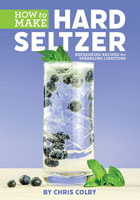 By Chris Colby Learn about the development of the current market and delve into the intricacies of sugars used in making seltzer. |
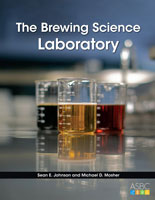 By Sean E. Johnson and Michael D. Mosher Provides a great introduction to the importance of a brewery laboratory for brewing science students and novice brewers and a handy reference manual for experienced professionals. |
 By Charles W. Bamforth In this accessible yet informative guide, Bamforth explains the processes behind the development of standard methods, how they are evaluated, and why they are important for accuracy and precision. |
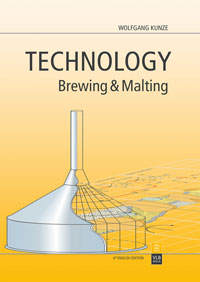 By Wolfgang Kunze and edited by Olaf Hendel This book contains didactically clear, graphic, and current descriptions of all essential malt and beer production aspects, from the raw materials to malt and beer production to filling and packaging. |
 By Richard J. Rench This book provides theoretical and the practical information needed by brewing professionals to identify and correct cleaning issues throughout the brewery. Following the recommendations in this book will improve brewery operations in measurable ways. |
 By Thomas Kraus-Weyermann and Horst Dornbusch This book addresses both historical and technical brewing topics with a balance of science and wit. |
 By Charles W. Bamforth Many factors affect color and clarity, and understanding them is key to producing beer that has the desired appearance every time. |
 Edited by Richard D. Cartwright, Donald E. Groth, Yeshi A. Wamishe, Christopher A. Greer, Lee A. Calvert, Casiana M. Vera Cruz, Valérie Verdier, and M. O. Way This easy-to-use book offers images and the latest practical information for diagnosis of diseases and pests. |
 By Sandra Taylor This book offers a new view of how the industry can be an important actor in sustainable agriculture and provides a unique insight for the consumer on what to look for on supermarket shelves. |
 Edited by G.M. Walker, C. Abbas, W.M. Ingledew, and C. Pilgrim There is no better tool for understanding the ethanol industry as The Alcohol Textbook. |
 By Charles W. Bamforth A reader-friendly guide that helps users identify and fix root causes of flavor stability issues, maximize stability performance, extend the shelf life of their beers. |
 Edited by Charles W. Bamforth This book presents a novel methodology on what goes into beer and the results of the process. |
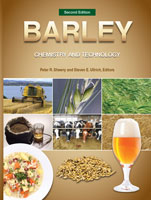 Edited by Peter R. Shewry and Steven E. Ullrich This book is a source of information for scientists, students and others who need to understand the development, structure, composition, or end use properties of barley grains related to their cultivation, trade, and utilization. |
 Edited by Ray Klimovitz and Karl Ockert Beer Packaging offers complete coverage of the packaging process from containers through handling and quality controls. It shares experiences from expert contributors to give you knowledge for real-life situations. |
 By Lucy Saunders It's a cookbook for people who enjoy carrots and kale, but also love beer, cheese and chocolate. |
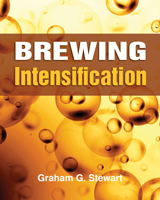 By Graham G. Stewart Improve volume, reduce costs, and improve time to market through intensification of the brewing process, including brewing operations, wort composition, yeast, fermentation, and maturation.
|
 By Charles W. Bamforth Six volumes of Dr. Charlie Bamforth's acclaimed "Practical Guides for Beer Quality" series, BEER SAFETY AND WHOLESOMENESS, QUALITY SYSTEMS, COLOR AND CLARITY, FRESHNESS, FLAVOR and FOAM |
 Edited by Alex Speers Proceedings of the 2nd International Brewers Symposium |
 Edited by Stephen R. Holle, Ray Klimovitz, Lars Larson, Karl Ockert, and Steve Presley This book includes an overview of the brewing process, a description of a multitude of beer styles worldwide, the rules for pairing food and beer, and the ingredients behind brewing. |
 Edited by Walter Mahaffee, Sarah Pethybridge, and David H. Gent A comprehensive and authoritative account of diseases and pests of hop as well as numerous other disorders and injuries that impact this valuable specialty crop. |
 Edited by Elke K. Arendt and Fabio Dal Bello This book covers the work presented at the First International Conference on Gluten-Free Cereal Products and Beverages. |
 By Takashi Inoue This comprehensive publication on diacetyl formation in fermented foods and beverages explains the science behind diacetyl formation, how to control it, and how to measure it in food manufacturing processes. |
 Edited by Grant M. Campbell, Martin G. Scanlon, and D. Leo Pyle This volume aims to enhance the appreciation of aerated foods and to provide stimulation and cross fertilisation of ideas for the exploitation of bubbles as a novel and versatile food ingredient. |
 Edited by Peter W. Gales (With 120 Cause-and-Effect Fishbone Diagrams by Greg Casey) 58 brewing science experts answer the "Who," "What," "How," and "Why" of brewing chemistry. |
 By Jamil Zainasheff and John Palmer In this book he teams up with homebrewing expert John J. Palmer to share award-winning recipes for each of the 80-plus competition styles. |
 Edited by Karl Ockert Get fast answers to technical questions on a variety of brewery engineering subjects in the production of specialty ales and lager beers. |
 By Chris Boulton and David Quain This unique volume provides a definitive overview of modern and traditional brewing fermentation written by two experts with unrivalled experience from years with a leading international brewer. |
 Written by Hartmut Evers and Hans J Manger; Translated by Robert Liedl, David Schleef, David Lewis, and Ken Belau; Edited by Lars Larson and Inge Russell Compressed air systems are the third most important utility in breweries and are often the most misunderstood. |
 Edited by Karl Ockert Written by industry experts, this resource is regarded as a trade standard achieving worldwide acceptance as an outstanding basic training tool in the art and science of brewing. |
 Edited by Karl Ockert Find fast answers to technical questions on the raw materials, brewhouse processes, and options used for producing Specialty Beers. |
 Edited by Jerry W. Heaps A complete update of one of our all-time best-selling books. |
 Edited by Karl Ockert Increase your Specialty Brewing knowledge with this easy-to-use handbook series! |
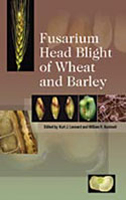 Edited by Kurt J. Leonard and William R. Bushnell Provides a comprehensive record of current knowledge on the nature of Fusarium head blight, the damage it causes, and current research on how to control it. |
 By Stephen R. Holle Provides a rare combination of a scientifically accurate and practical information written for sophisticated brewing professionals, educators, students, craft brewers, and home brewers. |
 Editado por Ray Klimovitz Spanish Edition. Written by industry experts, this resource is regarded as a trade standard achieving worldwide acceptance as an outstanding basic training tool in the art and science of brewing. |
 By Charles W. Bamforth This book covers the principles and practices of brewery quality so that brewers can establish or audit their own programs and procedures for producing consistent, high quality beer. |
 Edited by John T. McCabe Regarded as a trade standard achieving worldwide acceptance as an outstanding basic training tool in the art and science of brewing. |
 By Paul R. Mathewson Provides practical information in a straightforward non-technical manner for every food industry practitioner |
 Edited by D. E. Mathre Originally published in 1982, this edition is extensively revised. Changes include 26 additional color photographs, new sections, re-written sections, coverage of new diseases, etc. |
 MBAA This powerful brewing formulations and processing program assists brewers at every production level to improve existing beer formulations and design creative new brews. |